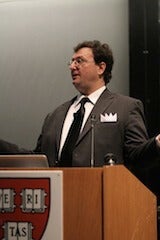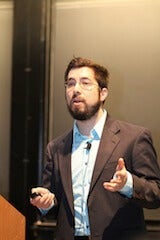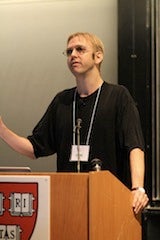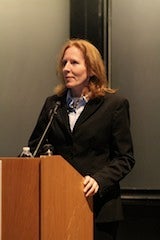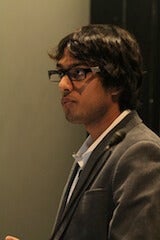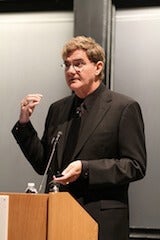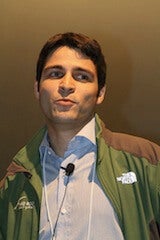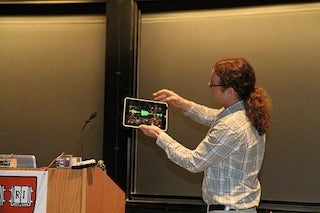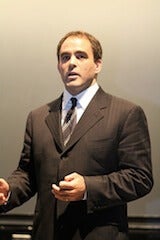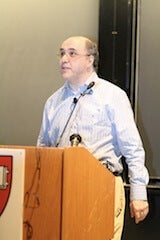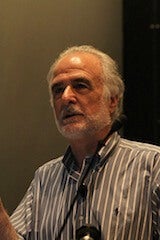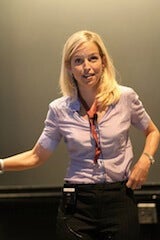H+ Summit @ Harvard: Rise of the Citizen Scientist – Review of Day 1

Share
The 2010 H+ Summit @ Harvard – Rise of the Citizen Scientist was quite an exciting event. Hosted by the Harvard College Future Society in Cambridge, MA, it featured a wide range of speakers describing their work related to all things singularity. Many of the presenters also addressed the theme of the summit, which was the rise of the citizen-scientist and how everyday people can be a part of cutting-edge scientific advancements. In this and subsequent posts, we’ll highlight some of the latest developments.
Alex Lightman – Rise of the Citizen Scientist
Alex Lightman, executive director of Humanity +, opened the conference by highlighting the theme of the citizen-scientist. As advancements in medicine allow us to live longer, the likelihood of experiencing existential risks within our lifetimes increases. Some of these existential risks include the decline of finite resources on earth (oil, fresh water), climate change, etc. As such, Alex advocates that all citizens need to be involved in creating the advancements that can allow humanity to avoid the realization of those risks. And in support of this viewpoint, it was noted that many famous scientists, including Isaac Newton and Albert Einstein, made significant contributions as independent citizen-scientists, rather than as members of large universities or multinational corporations.
Ed Boyden – Controlling Brain Circuits with Light
Ed Boyden presented one of the most intriguing lectures at the meeting. His Synthetic Neurobiology Group at MIT is taking an innovative approach to studying how specific brain circuits are involved in various processes. They took light-sensitive molecules that function only when exposed to a particular wavelength of light and introduced them into specific areas of a mouse’s brain. (These molecules exist naturally in green algae.) They discovered that they were able to activate those parts of the brain simply by flashing brief pulses of light.
Using this system, Ed described their latest work on treating blindness. His group compared blind and normal mice in their ability to solve a maze. As you can imagine, the blind mice performed significantly worse. However, after stimulating photoreceptors (specific cells involved in vision) in the blind mice, Ed found that they regained their vision and could complete the maze just as well as the normal mice! Hopefully this approach is one that cannot only treat human disease but also one that can lead to future human enhancements.
Alex Backer – Aging and Living Two Years Longer Using Your Cellphone
Alex Backer discussed the topic of aging and why evolution has selected for organisms that age and eventually die. He reasons that evolution favors aging as a way to maintain an optimal genetic distance between generations. Research has found that gametes (sperm and eggs) that fuse to form an offspring accumulate mutations over time. Therefore, each successive generation is slightly different than the previous one and this gradual change is what has allowed organisms to adapt to and survive in their environments. As an organism ages then, too many mutations accumulate and can be detrimental. This is why women are discouraged from giving birth at later ages.
So instead of lamenting this fact of nature, Alex decided to help people get the most out of their lives. He created a wireless system called QLess. Studies show that the average American spends 2 years of his life waiting in line. QLess allows subscribers to wait in a virtual line and get a message to their mobile device when they have reached the front of the line, whether it is at the DMV or in a busy store.
In the final part of his talk, Alex described his take on the theme of citizen-scientist. He has created a Wikipedia-like website called everybodyscience.org. The site is designed to allow anybody to publish results of their study or project, without the peer-review and inaccessibility of scientific journals. He claims that his work that he has published on everybodyscience.org has been viewed significantly more than what he has published in Nature, a top scientific journal. How about that for citizen science?
Melanie Swan – Democratizing the Genome
Melanie Swan focused her talk on the role of citizen-scientists in the genomic era. DNA sequencing is advancing faster than most other technologies, while also getting cheaper. In the process, large amounts of biological data are being generated, somewhere in the order of zettabytes. Further, we are moving closer to being able to edit genomic information. As such, Melanie believes that with time, everyday people will understand the intricate connections between a particular genotype and how it impacts a particular phenotype. For example, having a specific version of a gene might mean an elevated level of the protein it encodes. So if you have your genome sequenced and you know you have that gene, you can have blood or other tests done to confirm that you do indeed have higher levels of the protein. If this elevated level has detrimental effects, you can take specific medications/treatments to lower it or offset its effects. Further, the use of social networking sites and mobile apps can allow you to share this information for the benefit of others. This is the future that Melanie envisions: one where people understand and take responsibility for their health.
Kevin Jain – Transhumanism and a New Kind of Education
Kevin Jain is the founder and president of the Harvard College Future Society and one of the main organizers of the H+ Summit. He presented a great talk on the current lack of suitable educational opportunities focused on our rapidly evolving technology and its implications for the future of mankind. As he spent some time putting together a reading list for his own individualized study program at Harvard, Kevin had the idea of creating a textbook to deal with these issues. Once completed, he envisions that many colleges will be able to use it to develop formal classes and even courses of study that focus on these topics.
Ronald Bailey – The Democratic Threat to Transhumanism
Ronald Bailey presented an excellent talk on the role of government and society in regulating human augmentation and enhancement. He notes that currently, many laws in the US and other countries limit scientific research in areas that hold great potential, such as stem cell technology. In making his point, Ronald provides several parallel examples where the majority used the law to oppress the minority. Such parallels include civil rights for African-Americans and the current battle for the rights of gays to marry. Ronald concluded his talk with a call to arms of sort. He believes that people who desire enhancement must join together and work to ensure that the democratic majority does not infringe upon their rights.
Mikhail Shapiro – Stepping Stones: Getting to Enhancement by Focusing on Disease
Mikhail Shapiro gave a two-pronged talk dealing with human brain enhancements. First, he described how many technologies with the potential for human enhancement start out as treatments for disease. Mikhail specifically talked about some work he has been involved in where brain implants allowed paralyzed patients to regain partial use of their limbs after bypassing the injured spinal cord. However, once these technologies have been tested rigorously and have shown efficacy, it’s not a big jump to apply them for human enhancement.
The other aspect of Mikhail’s talk focused on taking these developments from the laboratory and creating successful businesses. Currently, he is involved with Third Rock Ventures, which seeks out and provides funding for biotechnology companies that have some key characteristics of success: a great product supported by sound science and rigorous testing, the ability to get the product to the market within 3 – 5 years, and a product that can easily move from treatment of disease to enhancement.
John Smart – Brain Preservation
John Smart’s presentation focused on brain preservation and provided many compelling reasons for pursuit of this technology. The particular method of preservation he is pursuing is called plastination and it involves embedding the brain in plastic for room-temperature storage. To accomplish this goal, John co-founded the Brain Preservation Foundation and is offering the Brain Preservation Prize, a cash prize to a group that can create the technology. He hopes that the prize will generate an incentive similar to the X Prize Foundation. So what are some reasons for preserving a human brain in plastic? Scientific reasons include the ability to study the “human connectome” – a map of the brain’s connections. Once we have a complete understanding of this, we can apply this knowledge in such ways as designing more human-like artificial intelligence, robots with human-level empathy, etc. Further, a person can leave her memories, culture and experiences for their friends and loved ones. And if the technology for mind uploading is developed, the preserved brain can be a source for transferring these memories and experiences into a robot or alternate body.
Be Part of the Future
Sign up to receive top stories about groundbreaking technologies and visionary thinkers from SingularityHub.


Timothy Marzullo – Backyard Brains: Neuroscience for Everyone
Timothy Marzullo's presentation was one of the best in addressing the citizen science theme. An electrophysiologist by training, Timothy has founded a company called Backyard Brains that provides low-cost electrophysiology equipment for students and amateur scientists. Called a SpikerBox, it allows a user to record a nerve cell as it executes an action potential, signifying its activation. The SpikerBox costs less than $100 and is very simple to use, as demonstrated by Timothy during his talk. He inserted electrodes into a cockroach leg and stimulated the nerve cells by touching the sensory hairs. Upon stimulation, the nerves fire and these action potentials were displayed on the screen and heard through the speakers. To make this technology even more accessible, Backyard Brains has created an iPhone app that will work with the SpikerBox if you don’t have a laptop available. Exciting science made simple and cheap. This is what citizen science is all about. Check out the video below from Backyard Brains for a fun demonstration.
Geordie Rose – Building Machines that Learn
Geordie Rose is the founder and chief technology officer of D-Wave Systems, a company that is focused on developing quantum computers. These computers would utilize the effects of quantum mechanics to perform calculations and are expected to be the next big advancement in computer technology. Currently, the best quantum computers are very limited, only handling about 10 qubits (quantum bits) of processing power, barely enough to run a simple calculator. However, new chips being tested by D-Wave are running about 128 qubits.
During his talk, Geordie presented a compelling argument that if we are to build machines that are truly capable of unsupervised learning, they will need to be based on quantum computing. Currently, Geordie’s team has shown that their quantum computing technology can be applied to create these sorts of machines. Without being told what is a car and what is not, their prototype has successfully determined which object is a car is from a picture containing various other items. And while this may seem simplistic at the moment (Geordie claims they have developed the most advanced car detector in the world!), it is an excellent first step in creating machines that can learn and adapt to their environment in real time.
Stephen Wolfram – Computation and the Future of the Human Condition
Stephen Wolfram was likely the most high-profile speaker during the first day of the H+ Summit. He spent the first part of his talk describing the capabilities of Mathematica and its development through the years. He also demonstrated the concept of the cellular automaton and how complex patterns can result from simple rules. As expected, Stephen did not fail to mention Rule #30 and how it’s discovery was quite a surprise to him!
In the second part of his talk, however, Stephen focused on the future of the human condition. He envisions a time when more and more of our engineering will be driven by mining the computational universe to discover algorithms that can be applied to our purposes. This will become a necessity as generating algorithms for increasingly complex problems becomes less efficient and more difficult.
Michael Smolens – dotSUB: Any Video, Any Language
Michael Smolens was a businessman who traveled the world to work with his clients and often had considerable difficulty in communication due to language barriers. So he took his frustration and turned them into a new passion, a company called dotSUB. This company is focused on developing technology that allow any video to be viewed in any language. Understanding the power of video to communicate important ideas and knowledge, dotSUB has already made considerable progress in their efforts. According to Michael, many videos that his company has helped translate have been viewed tens of thousands of times, sometimes even more in the foreign languages than in the native language they were created in! Further, dotSUB is also developing an iPhone app to see mobile videos in almost any language. And although he didn’t explicitly mention it, Michael’s work will be an important factor in expanding the role of citizen-scientists around the world.
Darlene Cavalier – Disrupting Science (in a good way)
Darlene Cavalier’s entire talk was dedicated to the topic of citizen science. Echoing some points made by other speakers, Darlene described how open data, increasingly cheaper instrumentation, and the relative ease of sharing information through the internet make this an excellent time for amateur scientists to make meaningful contributions. In support of her position, Darlene highlighted some recent examples of citizen science in action. These included the discovery of a large hole in Jupiter’s atmosphere by amateur astronomer Anthony Wesley and the discovery of a new species of cockroach by high school students Brenda Tan and Matt Cost in New York City. In order to facilitate the rise of the citizen-scientist, Darlene has co-founded ScienceforCitizens.net, a site dedicated to gathering information on several exciting and ongoing science projects that anyone can read about and get involved in.
For further reading, many of the powerpoint presentations can be viewed here.
[image credit: all images courtesy of A. Jolly]
[video credit: backyardbrains.com]
Related Articles

This Light-Powered AI Chip Is 100x Faster Than a Top Nvidia GPU

These Robots Are the Size of Single Cells and Cost Just a Penny Apiece

Hugging Face Says AI Models With Reasoning Use 30x More Energy on Average
What we’re reading

